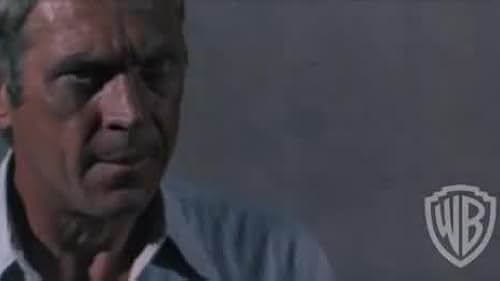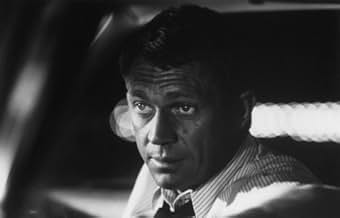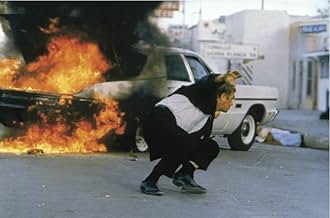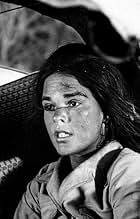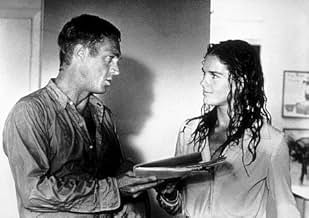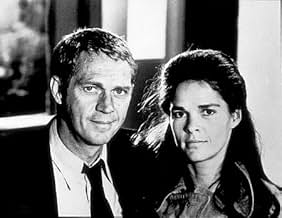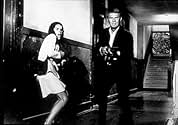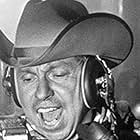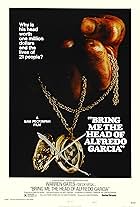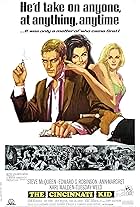A recently-released ex-con and his loyal wife go on the run after a heist goes awry.A recently-released ex-con and his loyal wife go on the run after a heist goes awry.A recently-released ex-con and his loyal wife go on the run after a heist goes awry.
- Awards
- 1 win & 2 nominations
- Director
- Writers
- All cast & crew
- Production, box office & more at IMDbPro
Storyline
Did you know
- TriviaSam Peckinpah's intake of alcohol increased dramatically while making the film, and he was fond of saying, "I can't direct when I'm sober."
- GoofsAfter the robbery, Doc and Carol's blue car plows through a neighboring porch. The windshield is clearly shattered by one of the broken porch columns. As soon as they are out of town, the blue car is immaculate.
- Quotes
Rudy Butler: That's a walk-in bank. You don't have to be Dillinger for this one.
Carter 'Doc' McCoy: Dillinger got killed.
Rudy Butler: Not in a bank.
- Alternate versionsTo get permission to release the film in Spain, which at the time was ruled by Francisco Franco, an additional sequence was tacked onto the end in which McCoy is captured and returned to prison, because it's bad for the moral health of the people to show that criminals can escape from paying their debt to society.
- ConnectionsEdited into The Kid Stays in the Picture (2002)
Featured review
Sick and tired of new releases I couldn't get through 45 minutes of, I went back to a classic: Sam Peckinpah's The Getaway. What a breath of fresh air this 1972 heist/chase movie turned out to be. In addition to hyper realistic characterizations of the McCoys (played by Steve McQueen and Ali MacGraw), everything else about this movie rings true. 35 years later, Peckinpah's signature slo-motion shoot outs stand up against anything in the theaters today. There's little to dislike about this movie and I can't help but wonder why movies aren't made like this anymore: no special FX, no over-the-top stunt sequences, no melodramatic dialogue, not fat, no filler. This is a movie made by real people, for real people. Plain and simple.
Technically, the stand-out aspect within The Getaway is the editing. Influenced by the French New Wave, Peckinpah defies convention by playing with time and space as he uses disjointed cuts to jump ahead in time before allowing the events within the movie to catch up to the present. The most interesting example of this occurs when Doc and Carol are at a busy park alongside a river. Doc has just been released from prison and he's soaking in the sights and sounds of freedom. Peckinpah cuts to a shot of Doc jumping into the river with his clothes on, followed by Carol. At first this feels like a fantasy in Doc's head since we abruptly cut back to the present where Doc is still standing and looking at the river. But soon he actually does run to and jump into the river. From there we cut directly to Carol's apartment where the two enter soaking wet and smiling. It is atypical and unexpected to see unconventional editing like this in mainstream American movies, but when it's done (and done right) there' something incredibly rewarding about having your brain (and expectations) teased in such a randomly disjointed (yet fluid) way.
Another example of unconventional yet incredibly effective montage happens in the opening thirty minutes. In this sequence Doc McCoy (McQueen) is locked up in prison and slowly losing his wits. Peckinpah portrays Doc's inner head space through a dizzying montage of shots of Doc in and around the prison, where synced sound cuts smash into one another in a relentlessly pounding and oppressive manner. You get the sense something has to break and before long you realize it's Doc's resolve.
Peckinpah proves with The Getaway that you don't need astounding source material to make a great movie. On the written page I'm sure this film seemed like a very standard heist/chase film. But by allowing the actors to bring realistic, idiosyncratic performances to the table and by utilizing unorthodox techniques, such as French New Wave inspired editing, Peckinpah elevates pulp into high art. I know I'm sounding like a broken record by saying this but: where are the artists in Hollywood today?
http://eattheblinds.blogspot.com/
Technically, the stand-out aspect within The Getaway is the editing. Influenced by the French New Wave, Peckinpah defies convention by playing with time and space as he uses disjointed cuts to jump ahead in time before allowing the events within the movie to catch up to the present. The most interesting example of this occurs when Doc and Carol are at a busy park alongside a river. Doc has just been released from prison and he's soaking in the sights and sounds of freedom. Peckinpah cuts to a shot of Doc jumping into the river with his clothes on, followed by Carol. At first this feels like a fantasy in Doc's head since we abruptly cut back to the present where Doc is still standing and looking at the river. But soon he actually does run to and jump into the river. From there we cut directly to Carol's apartment where the two enter soaking wet and smiling. It is atypical and unexpected to see unconventional editing like this in mainstream American movies, but when it's done (and done right) there' something incredibly rewarding about having your brain (and expectations) teased in such a randomly disjointed (yet fluid) way.
Another example of unconventional yet incredibly effective montage happens in the opening thirty minutes. In this sequence Doc McCoy (McQueen) is locked up in prison and slowly losing his wits. Peckinpah portrays Doc's inner head space through a dizzying montage of shots of Doc in and around the prison, where synced sound cuts smash into one another in a relentlessly pounding and oppressive manner. You get the sense something has to break and before long you realize it's Doc's resolve.
Peckinpah proves with The Getaway that you don't need astounding source material to make a great movie. On the written page I'm sure this film seemed like a very standard heist/chase film. But by allowing the actors to bring realistic, idiosyncratic performances to the table and by utilizing unorthodox techniques, such as French New Wave inspired editing, Peckinpah elevates pulp into high art. I know I'm sounding like a broken record by saying this but: where are the artists in Hollywood today?
http://eattheblinds.blogspot.com/
- frankenbenz
- Jul 16, 2008
- Permalink
Details
- Release date
- Country of origin
- Languages
- Also known as
- La huída
- Filming locations
- El Paso, Texas, USA(street scenes, Laughlin Hotel at 311 W Franklin Ave, and drive-in restaurant on Dyer St, both demolished)
- Production companies
- See more company credits at IMDbPro
Box office
- Budget
- $3,352,254 (estimated)
- Gross worldwide
- $9,588
- Runtime2 hours 3 minutes
- Color
- Aspect ratio
- 2.35 : 1
Contribute to this page
Suggest an edit or add missing content


